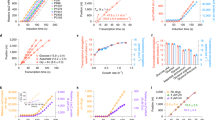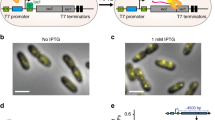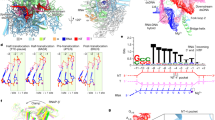Abstract
THE suA mutation in Escherichia coli is defined by its suppression of the polar effects of nonsense mutations on distal genes1. Richardson et al.2 discovered that two independent mutations in the suA gene affect the transcriptional termination factor rho. This suggests2 a mechanism for polarity: as long as ribosomes progress along the nascent message, transcription proceeds; but when ribosomal progress is blocked, exposure of the distal RNA somehow causes rho to terminate transcription prematurely. As others have noted3–6, the involvement of rho in translational polarity could explain several puzzling observations concerning the control of both transcription and translation. Richardson et al.2 proposed that rho may be the product of the suA gene. They hesitated to draw that conclusion, however, because they found a rather high level of rho activity, 9% of wild type, in a strain believed7 to contain an amber mutation in the suA gene (strain 2055). Either this amber lesion was extraordinarily leaky or, alternatively, the absence of suA gene function only partially and indirectly diminished the level of rho activity in the cell. The experiments reported here clarify this problem and argue that the transcriptional termination factor rho is indeed the direct protein product of the suA gene.
This is a preview of subscription content, access via your institution
Access options
Subscribe to this journal
Receive 51 print issues and online access
$199.00 per year
only $3.90 per issue
Buy this article
- Purchase on Springer Link
- Instant access to full article PDF
Prices may be subject to local taxes which are calculated during checkout
Similar content being viewed by others
References
Beckwith, J., Biochim. biophys. Acta, 76, 162–164 (1963).
Richardson, J. P., Grimley, C., and Lowery, C., Proc. natn. Acad. Sci. U.S.A., 72, 1725–1728 (1975).
Adhya, S., Gottesman, M., and de Crombrugghe, B., Proc. natn. Acad. Sci. U.S.A., 71, 2534–2538 (1974).
de Crombrugghe, B., Adhya, S., Gottesman, M., and Pastan, I., Nature new Biol., 241, 260–264 (1973).
Franklin, N., J. molec. Biol., 89, 33–48 (1974).
Segawa, T., and Imamoto, F., J. molec. Biol., 87, 741–754 (1974).
Morse, D., and Guertin, M., J. molec. Biol., 63, 605–608 (1972).
Ratner, D., J. molec. Biol., 88, 373–384 (1974), ibid., 89, 803–807 (1974).
Ratner, D., in RNA Polymerases (edit. by Chamberlin, M. and Losick, R.), (Cold Spring Harbor Laboratory, New York, in the press).
Wasmuth, J., and Umbarger, H., J. Bact., 116, 548–561 (1973).
Berg, D., Barrett, K., and Chamberlin, M., in Methods in Enzymology, (edit. by Grossman, L. and Moldave, K.), 21 D, 506–519 (Academic, New York, 1972).
Roberts, J., Nature, 224, 1168–1174 (1969).
Malamy, M., in The Lactose Operon (edit. by Beckwith, J. and Zipser, D.), 359–373 (Cold Spring Harbor Laboratory, New York, 1970).
Bertrand, K., et al., Science, 189, 22–26 (1975).
Brunel, F., and Davison, J., Molec. gen. Genet., 136, 167–180 (1975).
Author information
Authors and Affiliations
Rights and permissions
About this article
Cite this article
RATNER, D. Evidence that mutations in the suA polarity suppressing gene directly affect termination factor rho. Nature 259, 151–153 (1976). https://doi.org/10.1038/259151a0
Received:
Accepted:
Issue Date:
DOI: https://doi.org/10.1038/259151a0
This article is cited by
-
Autoregulation of gene expression:rho
Journal of Biosciences (1987)
-
Isolation and characterization of rho mutants of Escherichia coli with increased transcription termination activities
Molecular and General Genetics MGG (1984)
-
Autoregulation of the rho gene of Escherichia coli K-12
Molecular and General Genetics MGG (1984)
-
Temperature-sensitive mutant rho-115 rho-RNA binary complexes, and stabilization by substrates and analogues
Molecular and General Genetics MGG (1982)
-
A mutant rho ATPase from Escherichia coli that is temperature-sensitive in the presence of RNA
Molecular and General Genetics MGG (1981)
Comments
By submitting a comment you agree to abide by our Terms and Community Guidelines. If you find something abusive or that does not comply with our terms or guidelines please flag it as inappropriate.



